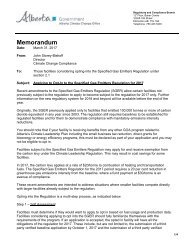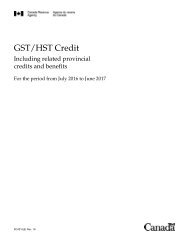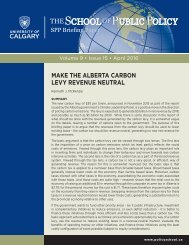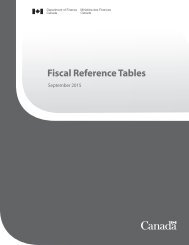China’s National Emissions Trading System
Chinas_National_ETS_Implications_for_Carbon_Markets_and_Trade_ICTSD_March2016_Jeff_Swartz
Chinas_National_ETS_Implications_for_Carbon_Markets_and_Trade_ICTSD_March2016_Jeff_Swartz
Create successful ePaper yourself
Turn your PDF publications into a flip-book with our unique Google optimized e-Paper software.
Global Economic Policy and Institutions<br />
15<br />
process in anticipation of the nationwide ETS.<br />
Highlighted below are the recommendations the<br />
NDRC has sent to local authorities to ensure MRV<br />
is conducted with efficiency:<br />
i. Monitoring: In a national system, monitoring<br />
would be self-conducted by covered entities<br />
directly. Those reports, once finalised,<br />
would set up the MRV system. Practicability,<br />
monitoring costs and appropriate parameters<br />
for the monitoring methods are all considered<br />
to be of top importance to the NDRC.<br />
ii. Reporting: Reporting of emissions and<br />
subsequent emissions reductions will be selffulfilled<br />
by covered entities in the ETS. The<br />
report must be sent to third party verifiers.<br />
The report sent to the verifier must include<br />
specific documents, activity data, and follow<br />
a strict reporting period.<br />
iii. Verification: The third party verifiers will<br />
issue a verification report which is sent to the<br />
covered entities for further adjustment and a<br />
cross-check. The seven ETS pilots only allow<br />
Chinese verification companies to perform<br />
verification services at this time.<br />
These MRV provisions will all likely feed into the<br />
national MRV system.<br />
The MRV measures China has put into place to date<br />
are typical of existing cap-and-trade programmes.<br />
China is quite protective of its emissions data and<br />
is notorious for not reporting full indicators of<br />
its emissions data to international organisations<br />
like the United Nations, although this is slowly<br />
changing. 36 Not surprisingly, international (non-<br />
Chinese) companies are currently not allowed to<br />
perform data verification services in the seven<br />
ETS pilots.<br />
4.4 Compliance and Penalties under <strong>China’s</strong><br />
Pilots<br />
Compliance with the ETS pilots amongst Chinese<br />
firms appears to have been largely stable to date,<br />
with little news reportage of non-compliance. All<br />
of the seven pilots have some form of financial<br />
penalties. These range from €1,500 to €7,000<br />
per violation, and there is an over 99 percent<br />
compliance rate across the ETS pilots to date. 37<br />
Companies must pay the financial penalty<br />
as well as surrender the original allowances<br />
which were not submitted at the time of the<br />
compliance “true-up” period (i.e., the due<br />
date for surrendering allowances to the local<br />
governments). In comparison, in the EU ETS,<br />
penalty fines are over €1 million per violation.<br />
The DRCs have also issued other penalties that<br />
are unique to China. In Shanghai, for example, if<br />
a company is found to be in non-compliance the<br />
following penalties can also be imposed:<br />
1. The Shanghai DRC can annul the company’s<br />
qualifications to gain future government<br />
financial support (subsidies), and annul its<br />
qualification to participate in government<br />
competitions as a “good performer” in<br />
energy-saving and other emissions reduction<br />
policies.<br />
2. The Shanghai DRC and other relevant<br />
government bureaus can ignore the<br />
application of new projects from the noncompliant<br />
company; in effect, revoking or<br />
not issuing construction or operating licenses<br />
for the company.<br />
3. If the company is a State-Owned Enterprise<br />
(SOE), the violation will be included into<br />
the annual performance assessment system<br />
of the firm by the government. This system<br />
is connected to the salary of the chief<br />
executive (the CEO). In effect, the CEO<br />
and the SOE’s performance review will now<br />
include compliance with the Shanghai ETS. 38<br />
4.5 The Pilots’ Offset Measures<br />
On 13 June 2012, the NDRC released the “Interim<br />
Measures on <strong>China’s</strong> Voluntary <strong>Emissions</strong><br />
<strong>Trading</strong>.” 39 Although the title of this interim<br />
measure mentions the term “voluntary emissions<br />
trading,” it means offsetting carbon emissions<br />
voluntarily by using credits produced from<br />
certified projects. These interim measures have<br />
assisted the seven ETS pilots in China by offering an<br />
offset mechanism in addition to their respective<br />
local allowance units. The NDRC commissioned<br />
“experts” to assess around 200 CDM project<br />
activity types already approved by the UNFCCC







